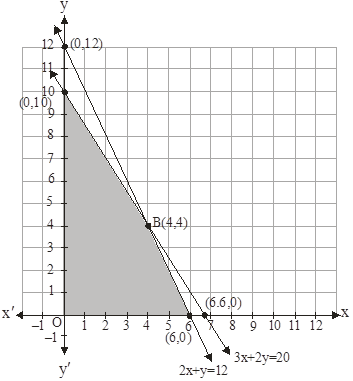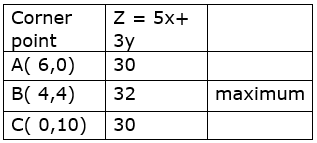A cottage industry manufactures pedestal lamps and wooden shades, each requiring the use of a grinding/cutting machine and a sprayer. It takes 2 hours on grinding/cutting machine and 3 hours on the sprayer to manufacture a pedestal lamp. It takes 1 hour on the grinding/cutting machine and 2 hours on the sprayer to manufacture a shade. On any day, the sprayer is available for at the most 20 hours and the grinding/cutting machine for at the most 12 hours. The profit from the sale of a lamp is Rs 5 and that from a shade is Rs 3. Assuming that the manufacturer can sell all the lamps and shades that he produces, how should he schedule his daily production in order to maximise his profit?
let the cottage industry manufacture x number of pedestal lamps and y number of wooden shades.
∴ x and y ≥ 0
The given information can be represented in the following tabular form:

The profit on lamps is Rs 5 and that on the shades is Rs 3.
∴ The constraints are 2x + y ≤ 12
And 3x + 2y ≤ 20
x, y ≥ 0
Total profit, Z= 5x + 3y
The mathematical formulation of the given problem is
Maximize Z = 5x + 3y
Subject to constraints
2x + y ≤ 12
And 3x + 2y ≤ 20
x, y ≥ 0
the feasible region determined by the system of constraints can be represented graphically as

The corner points are A( 6,0) , B( 4,4) and C( 0,10)
The value of Z at the corner points are as follows

The maximum value of Z is 32 at B(4,4)
Thus the manufacturer should produce 4 pedestal lamps and 4 wooden shades ti maximize his profits of Rs 32.